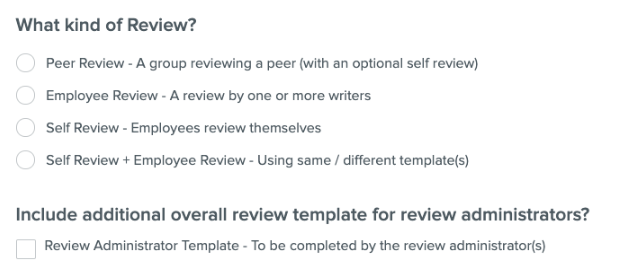Performance Cycle Types
Namely offers four different types of performance review cycles, and each behaves a bit differently. Reviewing these definitions and common use cases will help you select the appropriate option for your performance review cycle.
REVIEW CYCLE DEFINITIONS
-
Peer Review – This review is designed for peer feedback about an employee. Peers can be selected as you're configuring the review cycle, or you can assign nominators who can select the employee's peers. The nominator can be the employee themselves, if you'd like the employee to select their reviewers.
Self Reviews and Review Administrator Templates are commonly added to this review type to perform a "360" or "side-by-side" review.
-
Employee Review – This is a review of an employee, and can have multiple writers - none of whom will have visibility into the other reviews in the cycle. No self-review is included, and nominators are not allowed - the administrator must select the reviewers.
-
Self Review – This is a self-review where an employee is assessing their own performance, or answering survey questions.
Review Administrator Templates are commonly added to this review type, when configuring a Self Review with an Employee Review. The Review Administrator Template is used for the manager's review.
-
Self Review + Employee Review – This essentially combines the self review and employee review. An employee reviews their own performance, and an assigned writer (generally the manager) reviews the employee.
It's important to note that the reviewer will not be able to access the self-review (or any other employee reviews) with this review type. For this reason, many HR teams tend to select Self Review and add a Review Administrator Template when configuring a review.
-
Review Administrator Template - Selecting this option adds an additional review to your review cycle, and is commonly used to expand the functionality of Peer Reviews and Self Reviews.
The person assigned the Review Administrator Template gains administrative power over the review they're assigned to.
-
They can view all of the other reviews about the employee they're reviewing. For example, if you add a review admin to a Peer Review with a Self Review, the Review Administrator will have their own review to complete, and can also view the peer and self review for the employee.)
-
This visibility is important and will often help you determine which review cycle is best for your specific use case.
-
-
They can hide answers from anyone assigned to the review.
-
They can send answers back for revision.
-
They can amend the review once it has been completed.
-
They can change approvers, writers or nominators during or after the cycle.
COMMON USE CASE FAQS
Which review cycle type should I use if I want to perform a "360" review?
If you'd like to perform a "360" or "side-by-side" review - i.e., a review cycle that features a self-review, a peer review and a manager review, we recommend using the Peer Review cycle with a Review Administrator Template. In this scenario, the employee's manager would be assigned the Review Administrator Template. This works well, because the Review Administrator can view the self and peer reviews to help inform their review.
Which review cycle should I use if I want to perform a Manager Review with a Self-Review?
While Self Review + Employee Review will work for this type of review - we recommend selecting Self Review and adding a Review Administrator Template, because managers will be able to review the self-review as they're completing their review.
If you do not want managers to view the self-review, Self Review + Employee Review will work - but we've found that most HR teams want their managers to review their employee's reviews to best inform their own review.
Can I use the Performance tool to run surveys?
Yes - the Self Review cycle works well for surveys. It's important to note that the answers to the review would be visible to the Review Administrator.
Can I use the Performance tool for exit interviews?
Yes - we recommend the Self Review cycle for exit interviews.
Which review cycle should I use if I just want a manager to review an employee?
Employee Review will work best here - this is a simple one-to-one review, typically used when you'd like a manager to review a direct report only.
